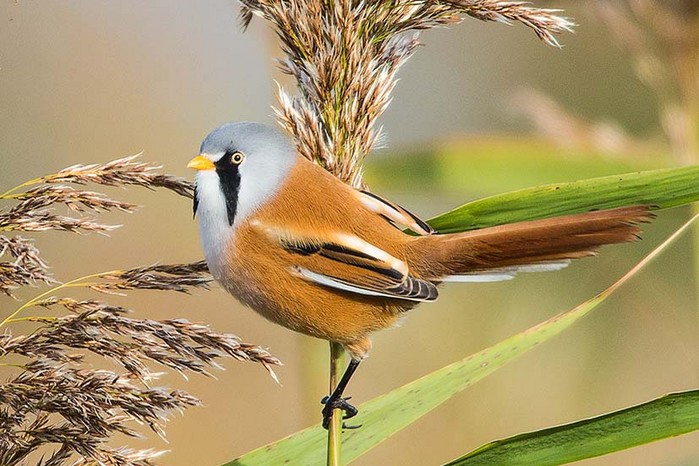Bearded Tits bounce back from population crash and hit record high
The Bearded Tit – one of Britain’s rarest breeding birds – has continued to bounce back from a population crash to the highest numbers recorded in the UK, according to the latest survey.

The Rare Breeding Birds in the UK report, published by the Rare Breeding Birds Panel, revealed that the Bearded Tit population has increased from 618 pairs in 2013 to 772 pairs in 2014 – the highest number since monitoring of Bearded Tits began in 1995.
The record population is made even more remarkable by the population crash that occurred in 2011. Bearded Tits are very sensitive to cold hard winters and this can have a knock on effect on their breeding success – the 2011 survey revealed the population had declined by nearly half to only 360 pairs after a disastrously cold December the previous year.
This is the third year in a row that numbers have increased and it is hoped that the work to improve and create more habitat for them across RSPB nature reserves will allow Bearded Tit numbers to continue to grow into a more stable population.
Dr Mark Eaton, RSPB Conservation Scientist and Chairman of the Rare Breeding Bird Panel, said: “It is always special to see Bearded Tits dancing and diving about the reedbeds on a crisp winter’s morning – such a charismatic bird.
“Unfortunately they are very sensitive to the hard winter weather and there was a big dip in numbers after a particular harsh weather in 2010. But when they have a good breeding season, like in recent years, they can produce lots of young so numbers can bounce back rapidly. As the population can fluctuate year on year it’s vital that we continue to manage the reedbeds they call home to give them the best chance of thriving.”
Named after their similarities with long-tailed tits and the dark facial markings on the males that resemble a moustache, Bearded Tits make their homes on well-managed reedbeds. The historic loss of this wetland habitat across the UK has resulted in the population becoming fragmented across isolated areas in the south west, eastern and northern parts of England.
The Humber, a large tidal estuary on the east coast of Northern England, is one area that has become a stronghold for Bearded Tits in the UK. Work to create new ponds and extra management of reedbeds has resulted in the population bouncing back, with good numbers at RSPB’s Blacktoft Sands helping to take the population on the Humber from around 40 to 250 pairs in just five years.
Pete Short, RSPB Humber Reserve Sites Manager, said: “Bearded Tits are a rare bird, which makes it all the more important that numbers are doing well. Over the last few years there has been a lot of hard work put in to creating new habitat for them on the Humber has allowed the population to boom.
“Five years on from the winter population crash, numbers have bounced back and to see Bearded Tits back on the Humber again in such good numbers is an amazing sight that many more people will now be able to enjoy.”
RSPB Blacktoft Sands remains the best place to see Bearded Tits in the North East of England, but the larger population means this distinctive looking bird can be spotted at many other sites in the UK including; RSPB Leighton Moss in Lancashire, RSPB Titchwell in Norfolk, RSPB Minsmere and RSPB Lakenheath Fen in Suffolk, and RSPB Radipole Lake and RSPB Lodmoor in Dorset.
13 December
Share this story





